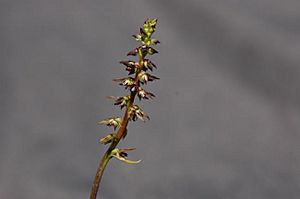Tallong midge orchid facts for kids
Quick facts for kids Tallong midge orchid |
|
|---|---|
 |
|
| Genoplesium plumosum near Goulburn | |
| Conservation status | |
| Scientific classification | |
| Genus: |
Genoplesium
|
| Species: |
plumosum
|
The Genoplesium plumosum, also known as the Tallong midge-orchid, is a special type of orchid. It is found only in New South Wales, Australia. This small orchid is quite rare. It grows in just a few places near the towns of Tallong and Wingello. It is easiest to spot when it flowers, which is only for about a month each year. Because it is so rare, the Australian government has listed it as an "Endangered" species. This means it needs special protection to survive.
Contents
What the Tallong Midge-Orchid Looks Like
The Tallong midge-orchid is a plant that grows on the ground. It lives for many years and loses its leaves at certain times. It has small roots and two round, potato-like parts called tubers underground. These tubers help the plant store food. A protective layer covers the tubers and reaches up to the soil surface.
Each orchid has one long, smooth leaf that is attached to its flower stem. This leaf is about 10–20 cm (4–8 in) long. The part of the leaf that is not attached to the stem is about 15–30 mm (0.6–1 in) long. It ends just below the flowers. If a plant is flowering, its leaf is solid. If it's not flowering, the leaf is hollow.
Flowers and How They Grow
The orchid's flowers grow on a spike that is 10–30 mm (0.4–1 in) tall. There are usually one to eight flowers on each spike. The flowers hang down a bit and are close together. Each flower is about 8 mm × 5 mm (0.3 in × 0.2 in) in size. They are greenish with purple stripes. The main lip of the flower, called the labellum, is purplish-red.
The top part of the flower, called the dorsal sepal, is shaped like a narrow egg. It is about 6–7 mm (0.2–0.3 in) long and 3 mm (0.1 in) wide. It has smooth edges and a pointed tip. The side sepals are longer and thinner, about 7.5–9 mm (0.3–0.4 in) long and 1 mm (0.04 in) wide. They spread out from each other.
The petals are also narrow and egg-shaped. They are about 5.5–6.5 mm (0.2–0.3 in) long and 1.5 mm (0.06 in) wide, with a long, pointed tip. The labellum is the most noticeable part. It is about 5 mm (0.2 in) long and 2 mm (0.08 in) wide. It has hairy edges and a pointed tip.
Life Cycle and Reproduction
The Tallong midge-orchid usually flowers about 4 to 6 weeks after it rains in summer or autumn. After flowering, the plant produces a dry seed pod called a capsule. This capsule opens up when it's ready and releases hundreds of tiny seeds.
How the Orchid Got Its Name
The first official description of this orchid was in 1942. A scientist named Herman Rupp found a specimen near Kurnell. He gave it the name Prasophyllum plumosum. Later, in 1989, two other scientists, David Jones and Mark Clements, decided to move this orchid and many others into a different group called Genoplesium.
The second part of its scientific name, plumosum, is a Latin word. It means "feathered." This probably refers to the hairy edges of its labellum, which might look a bit like feathers.
Where the Tallong Midge-Orchid Lives
The Tallong midge-orchid grows in forests. It likes to live among small shrubs and in areas with moss growing over sandstone rocks. Most of these orchids are found between Sydney Harbour and Marulan.
Protecting the Tallong Midge-Orchid
Sadly, the Tallong midge-orchid has not been seen in its original discovery spot for over 80 years. Now, it is only found in a small area of about 20 km2 (8 sq mi). In 2008, experts estimated there were only about 250 to 280 plants left near Tallong and Wingello. A few individual plants also live in the Morton National Park.
The main reasons this orchid is disappearing are:
- Land clearing: People cutting down forests and clearing land for other uses.
- Grazing by rabbits: Introduced European rabbits eating the plants.
Because of these threats, the Tallong midge-orchid is now listed as "Critically Endangered." This means it is at a very high risk of becoming extinct in the wild. Efforts are being made to protect its remaining habitats and help this special orchid survive.


